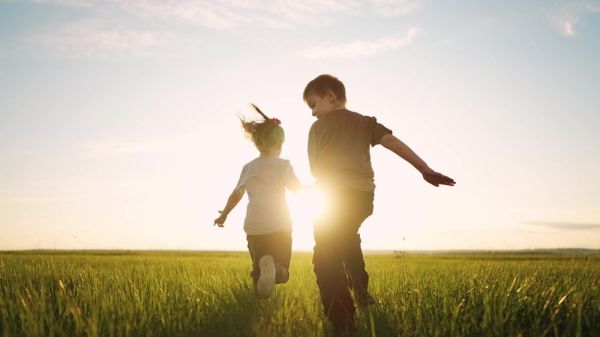Education to the Environment in Early Childhood Education Using General Abilities. Or What Are We to Do with Lucy?

Contemplating early childhood education in the environment inevitably brings forth the question of safety, security, and well-being. Once this is organized, we can get young children’s attention. Educational objectives, pertinent activities as well as specific strategies, will help us keep and cultivate their attention span. Education of the senses is fundamental in child development and educating them outside sets the milestones of education for the environment.
When considering young children, it’s easier to place them by age groups to organize our pedagogical approach. In my experience, three months old, six months, twelve months, sixteen to twenty-two months, three, four-, and five-years olds are all very different from one another. Researchers like Hubert Montagner[1] who study child development using a scientific approach also recognize those age groups. The reason is that the levels of development are marked by general abilities documented by researchers. Specific abilities like naming things, matching forms, singing, walking, holding a pencil, speaking using full sentences, and so on, are listed by age groups in all good books about child development.
General abilities like the one discussed in my last blog, namely "sliding their gaze towards an adult and holding it"[2], are less well known. Hubert Montagner has seen this ability in newborns.[3] I have seen children as young as twelve months old use this ability of "looking for the gaze of the adult, locking into it, and letting it pilot its own gaze"[4] to manage difficult and complex information like fear and flight, making a stand and fighting or dismissing information altogether. I have also observed that this ability seems to fade away around the age of five or six years old as autonomy is acquired. When educators or teachers lock into a child’s gaze, they can identify different looks like confusion, questioning, distrust, hatred, tiredness, distancing, fear, or on the contrary, looks of curiosity, interest, empathy, complicity, gladness, and fascination.
Noticing and documenting these looks can be extremely helpful in managing the behaviors of young children as they are individualistic by nature. The birth age of a three-year-old might be three but emotionally the child might be only two years old. A two-year-old might be intellectually a three-year-old. A four-year-old might be physically a five-year-old. "Individuals acquire the different physical, cognitive, and socioaffective abilities at different moments from zero to five years old."[5] Development is naturally uneven, and then generally around the age of five, young children have acquired equal abilities in all spheres. This makes education to the environment in early childhood a real challenge if it is done while grouping children. Reading their looks might be difficult if there are too many children in a group. Ensuring their safety, security, well-being, and education then might be impossible.
Recently, I met a three-year-old. I will call her Lucy. Now Lucy has blue eyes, long blond hair, and a bright smile. She can stand still for a few minutes. She can stop and seemingly listen to an adult. Then she is off with lightning speed from one room to another touching everything, opening cupboards, emptying containers, hiding in small spaces, and then reappearing as if everything was normal, settling down to play with stuffed animals. Lucy is a beautiful little girl, and she is unpredictable. When intercepted while using an unwanted behavior, like grabbing a fist full of icing off a cake on the table or climbing up a bookcase to grab an object, she just stops and smiles. She seems to listen to directions and explanations about the unwanted behavior, and then quickly runs away. This three-year-old has acquired the physical and cognitive abilities of her birth age. She is intelligent. However, her socioaffective and linguistic abilities are more than that of a two-year-old, though I have no doubt that by the time she reaches five years of age, all of her abilities will be up to par.
Now imagine Lucy in a group of three-year-olds participating in a nature activity. Remember that all the individuals in that group have acquired different levels of abilities. Group management here requires planning and profiling, as well as additional adults assigned specifically to children like Lucy.
Coming back to the general ability of "looking for the gaze of the adult, locking into it, and letting it pilot its own gaze" defined by Hubert Montagner. Educators and teachers prior to an outing can practice this ability for weeks while playing with the children. Using cues to catch their eye, locking into their gaze, and playfully settling it onto an object, person or location can be integrated by all children of the group. This general ability can be very useful in managing a group of preschoolers.
In this blog I have discussed analyzing the gaze of young children for information on their state of mind, practicing the general ability to lock into and pilot their gaze, and recognizing in children from zero to five years old that the development of their abilities is naturally uneven as a phenomenon in early childhood education. This is the understanding of an anthropologist, not that of a psychologist. I have observed that young children apply their energy to developing mainly one aspect of their development from birth to four years of age. Then around five they suddenly upgrade all their abilities at once under the effect of socialisation and a little more maturity.
My blogs this year will discuss other general abilities in young children like symbolic affiliation and its behaviors, visual attention and its span, impulses to interaction, development of the link between the word and the gesture, imitation, and learning, as studied by Hubert Montagner. I will also discuss group management for babies, two-, three-, four- and five-year-olds related to education in the environment. Going outside with babies who cannot walk, two-year old’s who tire easily, three-year old’s who need to go to the bathroom all the time, four-year old’s who get bored easily, and five-year old’s who can’t get enough of everything are challenging.
If you liked this blog or have any questions, please write to me: Suzanne.major@umontreal.ca
Works Cited
- Montagner, H. (2006: 194). L’attachement. Les débuts de la tendresse. Odile Jacob, 331 pages.
- Montagner, H. (2006: 227). L’arbre enfant. Une nouvelle approche du développement de l’enfant. Odile Jacob, 353 pages.
- Montagner, H. (2003: 45). L’attachement. Des liens pour grandir plus libre. L’Harmattan. 207 pages.
- Idem. (2003: 45)
- Major, S. (2014: 100, 103). Mamès, profèsorn oun kinder likth. Éducation en petite enfance en CPE. Le cas des femmes hassidiques Belz en services de garde en milieu familial accrédités, Thèse de doctorat, Université de Montréal, Département d’anthropologie, 294 pages.

